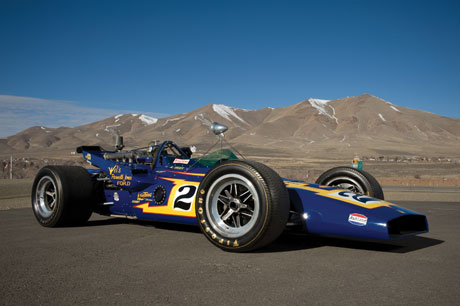Chassis Number: T1502
The advantages of four-wheel drive had been shown at Indianapolis in 1967, and George Bignotti sought to profit by combining it with the Ford V8 in 1968. He bought a single four-wheel-drive Lola with Ford V8 power for Al Retzlaff, to be driven by Al Unser. It was this car. In the 500, Unser qualified the 4WD Lola outside the second row in sixth position but crashed on lap 40 when a spindle broke. After being repaired in England, it returned in time for the USAC road course race at Indianapolis Raceway Park. Unser proved his versatility by winning both ends of the two-heat feature.
A major development in 1969 was the foundation of Vel’s Parnelli Jones Ford team. With backing from Ford and Firestone, Vel Miletich and Parnelli Jones bought out Al Retzlaff and acquired along with his Lola-Fords the services of legendary chief mechanic George Bignotti and driver Al Unser. The objective was to dominate USAC racing in North America and also race competitively in international Grands Prix, carrying the Firestone banner into Goodyear territory.
USAC had reacted to the perceived advantages of 4WD by restricting them to just ten-inch tire widths, effectively robbing the promising but expensive technology of its advantage, and not incidentally protecting the installed base of USAC car owners. Bignotti converted this car, wearing USAC #3 signifying Al Unser’s 1968 driving championship standing, to rear-wheel drive, with side-mounted fuel cells and the distinctive “coal chute” rear decks feeding air to rear-mounted oil coolers. Recognizing the extent of the modifications, it was renamed the Vel’s Parnelli Jones Special. Unser capped this T150 Indy Car’s season with a win from the pole at Phoenix on November 15.
For 1970, the Lola-based Vel’s Parnelli Jones Special was again modified with aerodynamic improvements and changed its identity to “Lola Colt.” Miletich and Jones signed Topper Toys as the team’s season-long sponsor. Its dramatic “Johnny Lightning” blue livery with bold yellow lightning bolts outlined in red has become one of racing’s most recognized and brilliant liveries. For the 1970 season, this car became Al Unser’s entry on short paved ovals and road courses on his way to a legendary season. With this car he won at Phoenix in the season opener, at Indianapolis Raceway Park in July, the Tony Bettenhausen 200 at Milwaukee in August, and the Trenton 300 in October.
The Lola-Ford/Vel’s Parnelli Jones Special/Lola Colt is a rare, important survivor of the era. It started the Indianapolis 500 three times. Its history as the contributor of 2,930 points to Al Unser’s historic total 5,130 points in 1970 marks it as one of the most important USAC Championship cars of its, or any, period.

